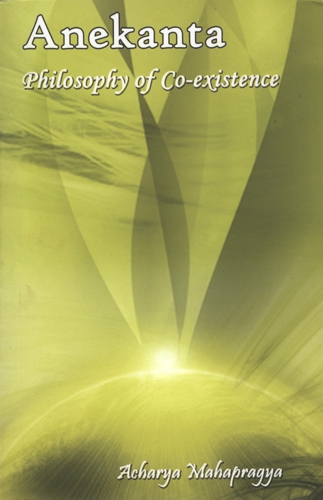Chapter 6

The Doctrine of Nayas: Infinite Modes and Infinite Approaches
Pantoscopic Viewpoint
Naigama NayaA substance is possessed of an infinite number of attributes, but it does not possess all kinds of attributes. Thus a soul has an infinite number of attributes, just like a non-soul (i.e. substance other than soul). There is absolute non-existence (atyantābhāva) between a soul and non-soul mutually, that is a soul can never become a non-soul and non-soul can never become a soul. The reason for such absolute non-existence is their own specific natures. A soul is possessed of the specific attribute of consciousness, which is absolutely non-existent in a non-soul. The category of a non-soul comprises five substances:
- Dharmāstikāya, which has the attribute of being the medium of motion.
- Adharmāstikāya, which has the attribute of being the medium of rest.
- Ākāśāstikāya, which provides accommodation.
- Matter, which has the attributes of colour, odour, taste and touch.
- Time, which has the attribute of duration.
The above specific attributes of the non-soul are absolutely non-existent in the soul. These specific attributes constitute the dividing line, between the soul and the non-soul. On the basis of the generic attributes, it is, however, possible to establish unity between the soul and the non-soul and their absolute difference can also be asserted on the basis of specific attributes as noted above. A substance has a character of its own. Its substance-hood is not dependent upon external relations and spacio-temporal determinations. Each substance has its own basic nature, its own specific Particularity. It acquires fresh attributes from various relationships, and determinations, but such attributes are not fte defining characteristics of it.
A substance possesses attributes and, therefore, it is called the substratum (dharmi) of those attributes. The attributes are two fold - qualities and modes. The qualities coexist with the substance while the modes occur in succession. Consciousness is a co-existing attribute of a soul, while pleasure, pain, happiness, sorrow etc. are attributes that occur in succession. An attribute and its substratum are neither absolutely different nor absolutely identical. An attribute can exist only in its substratum, and, therefore, there is non-absolute difference between them on account of this relationship of the content and the contained. The substance is one unitary principle, while the attributes are many, and from this viewpoint they cannot be absolutely identical, as one and many have evidently contrary natures. Identity and difference are thus synthesized in a substance. Such synthesis gives rise to two distinct experiences. Thus (1) the proposition 'the soul exists' embodies the experience of the predominance of identity. The attribute of knowledge is not intended here to be distinct from the substratum soul. (2) The proposition 'the soul is possessed of knowledge' embodies the experience in which the element of difference is predominant. Here the attribute of knowledge is intended to be a feature different from the substratum soul.
In brief, the attribute is subordinate in the viewpoint of identity, while the substratum occupies a predominant place in such experience. In the viewpoint of difference the positions of the attribute and the substratum are reversed.
The cycle of modes ceaselessly revolves about a substance. The modes that occur at the present moment are existent (real) and those that are past and about to come are non-existent (unreal). While the existent mode is related to the object, the non-existent one is to knowledge. The mode that is past does not reside in the object, but is merely an object of knowledge. We imagine an object and construct an image of it. The image, however, does not exist in the world outside, but that remains as an idea inside. The modes, past and future, are ideas in the mind. The will is a element, and the experience arising from it determines our activity. The pantoscopic viewpoint accepts also the element of the will. The authenticity of the popular concepts of causality, substratum etc. is established on the testimony of this way of pantoscopic observation.
- The Treatment of Cause as an Effect
In the proposition 'this is one year old plant' the transformation of plant is the effect while the period 'one year old' is the cause. The identification of plant with 'one-year-oldness' is by way of treatment of the cause as identical with its effect.
- The Treatment of Effect as Cause
In the proposition 'violence is suffering', violence is intended to be the cause of suffering. Here violence itself is identified with suffering by way of the treatment of the effect as identical with the cause.
In the usages like the above, the subject-predicate relation is determined on the basis of causality, which justifies the act of predicating a cause of an effect, or an effect of a cause.
- The Treatment of the Content as the Container
In the proposition 'the summit of the cosmos is the place of emancipation (mokṣa)’, the cosmic summit is not intended to be called emancipation which really belongs to the soul and not to any particular place in the cosmos.
- The Treatment of Container as the Content
In the proposition 'the dais is shouting', what is meant is that the persons seated on the dais are shouting. Here the container, viz. the dais has been used to denote the content viz. the persons seated on it.
Although the pantoscopic viewpoint is right so far as its own place of application is concerned, it becomes a pseudo-naigama viewpoint as soon as it engages itself in considering the difference between an attribute and its substratum, or between a part and the whole as absolute and eternal. The Vaiśesika system, according to this estimation of element, is an instance of pseudo-naigama viewpoint, because it considers an attribute as absolutely different from its substratum.
 Acharya Mahaprajna
Acharya Mahaprajna

